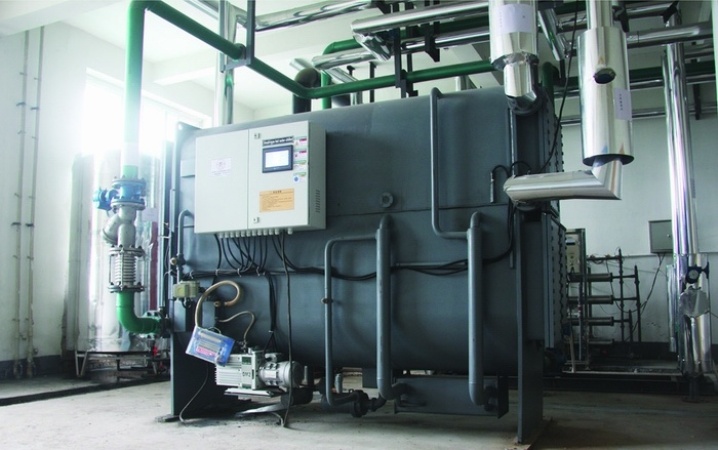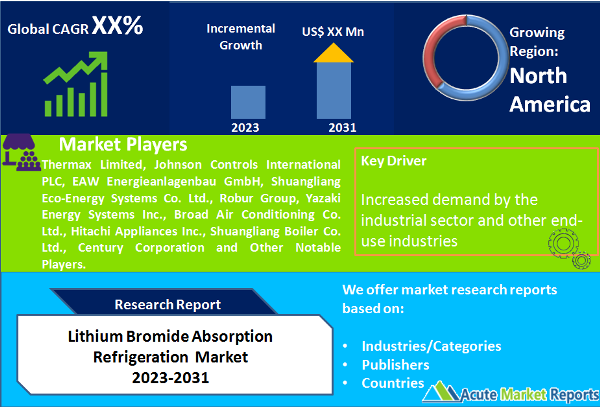
The lithium bromide absorption refrigeration market is a growing segment of the refrigeration industry that utilizes lithium bromide as the absorbent and water as the refrigerant in a thermally driven refrigeration cycle. This technology is commonly used in commercial and industrial applications for air conditioning, refrigeration, and process cooling in areas where electricity is expensive or not readily available. The market revenue for lithium bromide absorption refrigeration has been steadily increasing due to the rising demand for energy-efficient and sustainable cooling solutions in various industries. The increasing focus on reducing greenhouse gas emissions and the need for environmentally friendly refrigeration technologies have driven the adoption of lithium bromide absorption refrigeration systems. Factors such as the increasing demand for cooling in emerging economies, stringent regulations on the use of synthetic refrigerants, and the growing adoption of renewable energy sources are expected to drive the market's growth.

Increasing Demand for Energy-Efficient and Sustainable Cooling Solutions
The demand for energy-efficient and sustainable cooling solutions is one of the key drivers of the lithium bromide absorption refrigeration market. With growing concerns about environmental sustainability and the need to reduce greenhouse gas emissions, industries, and commercial buildings are increasingly looking for refrigeration technologies that are eco-friendly and energy-efficient. Lithium bromide absorption refrigeration systems are known for their ability to operate on low-grade heat sources, such as waste heat or renewable energy, making them a sustainable choice for cooling applications. According to a report published by the International Energy Agency (IEA), the demand for cooling is expected to triple by 2050, driven by factors such as urbanization, rising temperatures, and changing lifestyles. This increasing demand for cooling is pushing industries and buildings to adopt more energy-efficient and sustainable refrigeration technologies, including lithium bromide absorption refrigeration.
Stringent Regulations on the Use of Synthetic Refrigerants
Stringent regulations on the use of synthetic refrigerants, such as hydrofluorocarbons (HFCs), are driving the adoption of alternative refrigeration technologies, including lithium bromide absorption refrigeration. HFCs are known for their high global warming potential (GWP) and are being phased out in many countries as part of efforts to reduce greenhouse gas emissions. This has led to a growing need for sustainable refrigeration solutions that do not rely on synthetic refrigerants. The Kigali Amendment to the Montreal Protocol, which came into effect in 2019, mandates the phase-down of HFCs globally. Many countries have also implemented regulations, such as the European Union's F-Gas Regulation, which sets limits on the use of HFCs in refrigeration and air conditioning systems. These regulations are driving the adoption of alternative refrigeration technologies, including lithium bromide absorption refrigeration, as a more sustainable and environmentally friendly option.
Growing Adoption of Renewable Energy Sources
The growing adoption of renewable energy sources, such as solar and waste heat, is another driver of the lithium bromide absorption refrigeration market. Lithium bromide absorption refrigeration systems can operate using low-grade heat sources, making them compatible with renewable energy systems. The use of renewable energy sources not only reduces the reliance on fossil fuels but also provides a sustainable and cost-effective solution for powering refrigeration systems. According to the Renewables 2020 report published by the International Energy Agency (IEA), renewable energy is set to be the only source of energy that will experience growth in 2020 despite the COVID-19 pandemic. The increasing adoption of renewable energy sources in various industries, buildings, and households are creating a favorable environment for the deployment of lithium bromide absorption refrigeration systems, which can utilize these renewable energy sources to drive the cooling process.
Initial High Installation and Maintenance Costs
One of the key restraints for the lithium bromide absorption refrigeration market is the initial high installation and maintenance costs associated with these systems. Compared to conventional vapor compression refrigeration systems, lithium bromide absorption refrigeration systems tend to have higher upfront costs due to the complex design and specialized components required for the absorption process. Additionally, these systems may require regular maintenance and servicing, which can further add to the overall cost of ownership. The specialized components, such as absorbers, generators, and heat exchangers, required for the absorption process can be expensive to manufacture and install. Moreover, the need for regular maintenance, such as descaling and cleaning of the lithium bromide solution, can add to the ongoing operating costs of these systems, making them relatively more expensive compared to traditional refrigeration technologies. The initial high installation and maintenance costs associated with lithium bromide absorption refrigeration systems can be a significant barrier to adoption, especially for small and medium-sized enterprises (SMEs) or price-sensitive markets. However, advancements in technology, economies of scale, and government incentives for adopting energy-efficient solutions may help to mitigate this restraint and drive wider adoption of lithium bromide absorption refrigeration systems in the future.
Lithium Bromide-Water Absorption Chillers Led the Forecast Growth
Lithium bromide absorption refrigeration systems are primarily categorized into two types based on the working fluid used: lithium bromide water and lithium bromide ammonia. Among these, lithium bromide-water absorption chillers are the most dominant product type in the market in terms of both revenue and projected highest CAGR during the forecast period of 2025 to 2033. Lithium bromide-water absorption chillers, also known as single-effect absorption chillers, use water as the refrigerant and lithium bromide as the absorbent. These chillers are widely used in various commercial and industrial applications, such as air conditioning in large buildings, process cooling in manufacturing facilities, and refrigeration in data centers and hospitals. They are known for their high efficiency and ability to operate using low-grade heat sources, making them suitable for sustainable cooling solutions. The lithium bromide absorption refrigeration market is dominated by the lithium bromide-water segment, accounting for the highest revenue share in 2024. The dominance of lithium bromide-water absorption chillers in the market can be attributed to their advantages, such as high efficiency, compatibility with low-grade heat sources, and suitability for a wide range of applications. These chillers are well-established in the market and have a long history of successful implementation, making them a preferred choice for many industries and commercial buildings.
North America remains the Global Leader
North America is a prominent market for lithium bromide absorption refrigeration systems, accounting for a significant revenue percentage. The region has a mature and well-established market for absorption chillers, with a high adoption rate in commercial buildings, data centers, and other industrial applications. The demand for energy-efficient and environmentally friendly cooling solutions in North America has been driven by factors such as increasing awareness about sustainability, stringent environmental regulations, and incentives for adopting green technologies. The Asia Pacific region is a prominent market for lithium bromide absorption refrigeration systems, with significant revenue generation and projected high CAGR during the forecast period of 2025 to 2033. The region has witnessed a growing demand for efficient and sustainable cooling solutions due to rapid industrialization, urbanization, and increasing awareness about energy conservation and environmental sustainability. Asia Pacific, with its emerging economies such as China and India, has been experiencing a surge in demand for cooling solutions driven by factors such as rising population, increasing disposable incomes, and expanding commercial and industrial sectors. These factors have led to a higher demand for air conditioning, process cooling, and refrigeration in the region, thereby fueling the growth of the lithium bromide absorption refrigeration market.
Market Competition to Intensify during the Forecast Period
The lithium bromide absorption refrigeration market is highly competitive, with the presence of several key players striving to gain a competitive edge. These players are engaged in various strategic initiatives to expand their market share and maintain their competitive position in the industry. Some of the leading players in the global lithium bromide absorption refrigeration market include Thermax Limited, Johnson Controls International PLC, EAW Energieanlagenbau GmbH, Shuangliang Eco-Energy Systems Co. Ltd., Robur Group, Yazaki Energy Systems Inc., Broad Air Conditioning Co. Ltd., Hitachi Appliances Inc., Shuangliang Boiler Co. Ltd., and Century Corporation. These players have a strong global presence and offer a wide range of lithium bromide absorption refrigeration systems catering to different applications and end-use industries. Companies are investing in research and development to introduce innovative and advanced lithium bromide absorption refrigeration systems that are more energy-efficient, environmentally friendly, and suitable for a wide range of applications. For instance, players are focusing on developing absorption chillers with a higher coefficient of performance (COP), improved heat exchangers, and enhanced controls to optimize the performance of the system. In conclusion, the lithium bromide absorption refrigeration market is highly competitive, with key players adopting strategies such as product innovation, market expansion, customization, sustainability, and marketing efforts to gain a competitive edge. These strategies enable them to offer advanced and efficient solutions, expand their customer base, and enhance their brand reputation in the global market.
Historical & Forecast Period
This study report represents analysis of each segment from 2023 to 2033 considering 2024 as the base year. Compounded Annual Growth Rate (CAGR) for each of the respective segments estimated for the forecast period of 2025 to 2033.
The current report comprises of quantitative market estimations for each micro market for every geographical region and qualitative market analysis such as micro and macro environment analysis, market trends, competitive intelligence, segment analysis, porters five force model, top winning strategies, top investment markets, emerging trends and technological analysis, case studies, strategic conclusions and recommendations and other key market insights.
Research Methodology
The complete research study was conducted in three phases, namely: secondary research, primary research, and expert panel review. key data point that enables the estimation of Lithium Bromide Absorption Refrigeration market are as follows:
Market forecast was performed through proprietary software that analyzes various qualitative and quantitative factors. Growth rate and CAGR were estimated through intensive secondary and primary research. Data triangulation across various data points provides accuracy across various analyzed market segments in the report. Application of both top down and bottom-up approach for validation of market estimation assures logical, methodical and mathematical consistency of the quantitative data.
| ATTRIBUTE | DETAILS |
|---|---|
| Research Period | 2023-2033 |
| Base Year | 2024 |
| Forecast Period | 2025-2033 |
| Historical Year | 2023 |
| Unit | USD Million |
| Segmentation | |
Product
| |
Applications
| |
|
Region Segment (2023-2033; US$ Million)
|
Key questions answered in this report